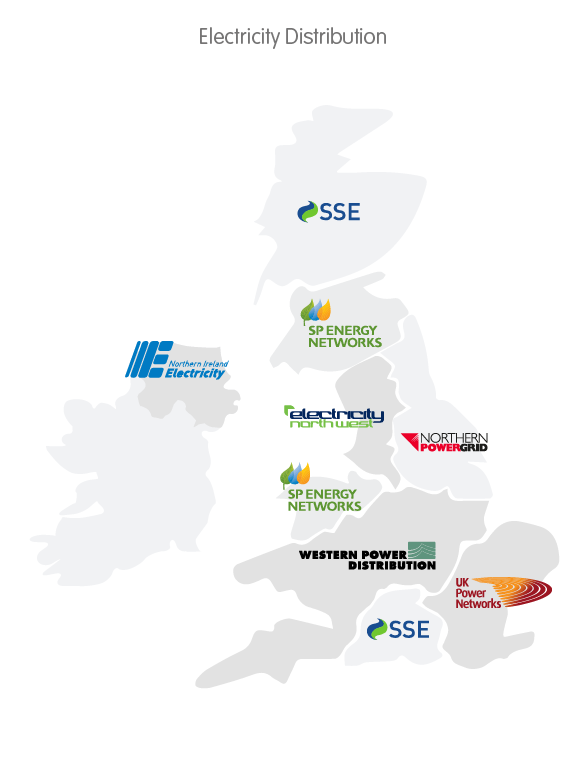Help
Help >>Regulatory>> DNO: Distribution Network Operators in the UK
DNO: Distribution Network Operators in the UK
A short guide to electricity distribution companies and what they do
This guide is intended to provide general guidance only. It is not intended to give you advice on your personal financial circumstances. You should seek independent professional advice if you’re unsure about anything mentioned in this guide or what choices to make.
A Distribution Network Operator is a company licensed to distribute electricity in the UK. These companies own and operate the system of cables and towers that bring electricity from the national transmission network to our homes and businesses.
Unlike the widely known Big Six energy companies that sell electricity to consumers, many of the leading distribution companies are largely unknown to the public. In this guide we’ll look at what they do and who they are.
What is a Distribution Network Operator (DNO)?
Although most people in the UK are familiar with the energy company they buy their electricity from, they actually rely on four types of companies to keep the lights on. These companies make up the UK power network:
- Generation: power plant ownership and operation
- Transmission: operate high voltage transmission networks
- Distribution: operate local distribution via towers, cables and meters
- Suppliers: electricity sellers like the Big Six and Boost
The company that is responsible for the distribution of electricity from the national transmission grid to your home or business is the Distribution Network Operator, or DNO. These are the people you should call if there is a power cut, as they are responsible for the network of towers, transformers, poles, cables and meters that deliver power to your home. If you are experiencing a power cut call 105, this is free from most landline and mobile numbers and will put you straight through to your District Network Operator.
DNO regions and operators
In Great Britain there are 14 different district networks or DNO regions. However, because these 14 regions are managed by just six operators, it is relatively simple to work out who yours is.
The map below from the Energy Networks Association provides a good visual idea of where they operate. If you are looking to work out who your DNO is then check the map; contact details follow in the table below.
Who is my District Network Operator?
The map above should give you a good idea as to who you Distribution Network Operator is. If you’d like to contact them check out the details below from the ENA:
UK District Network Operators
| Area (code) | Company | Emergency No. | Website | Twitter account |
|---|---|---|---|---|
| North Scotland (17) | SSE Power Distribution | 0800 300 999 | www.ssepd.co.uk | @ssencommunity |
| Central and Southern Scotland (18) | SP Energy Networks | 0800 092 9290 | www.spenergynetworks.co.uk | @SPEnergyNetwork |
| North East England (15) | Northern Powergrid | 0800 668 877 | www.northernpowergrid.com | @Northpowergrid |
| North West England (16) | Electricity North West | 0800 195 4141 | www.enwl.co.uk | @ElectricityNW |
| Yorkshire (23) | Northern Powergrid | 0800 375 675 | www.northernpowergrid.com | @Northpowergrid |
| Merseyside, Cheshire, North Wales and North Shropshire (13) | SP Energy Networks | 0800 001 5400 | www.spenergynetworks.co.uk | @SPEnergyNetwork |
| East Midlands, West Midlands, South Wales & South West England (11, 14, 21, 22) | Western Power Distribution | 0800 6783 105 | www.westernpower.co.uk | @wpduk |
| Eastern England (10) | UK Power Networks | 0800 783 8838 | www.ukpowernetworks.co.uk | @UKPowerNetworks |
| Southern England (20) | SSE Power Distribution | 0800 072 7282 | www.ssepd.co.uk | @southernelecPD |
| London (12) | UK Power Networks | 0800 028 0247 | www.ukpowernetworks.co.uk | @UKPowerNetworks |
| South East England (19) | UK Power Networks | 0800 783 8866 | www.ukpowernetworks.co.uk | @UKPowerNetworks |
| Northern Ireland | Northern Ireland Electricity | 0345 764 3643 | www.nie.co.uk | @NIElectricity |
DNO by postcode
If for some reason you can’t work out who you should call from the map and tables above, then simply click this link and enter your postcode to find out.
District Network Operator solar connection
Whenever you connect a form of electricity generation to the grid, you need to inform your local Distribution Network Operator (DNO). In general this is not a big issue, but you should be aware that your responsibilities are different depending on the size of the system you are looking at. Any installer registered with the Microgeneration Certification Scheme should be well aware of these details, but it's worth being clear yourself:
Smaller systems: If you are connecting a small system (up to 16A per phase or 3.7 kW), then your installer just needs to inform the DNO with 28 days of the system’s commissioning. Such small systems are unlikely to result in load issues for the local grid, so the regulation is relatively simple. For more details consult this guide on the G83/2engineering recommendation.
Larger systems: For bigger systems your installer will need to get permission from the DNO in order to connect to the grid. In many cases this will require a network study (which you may be charged for) to ensure that the local grid network is adequate for the power your system will produce. If the grid needs additional work to cope with the energy from your system, the DNO is required to provide you with a quote for the work within 45 days.
